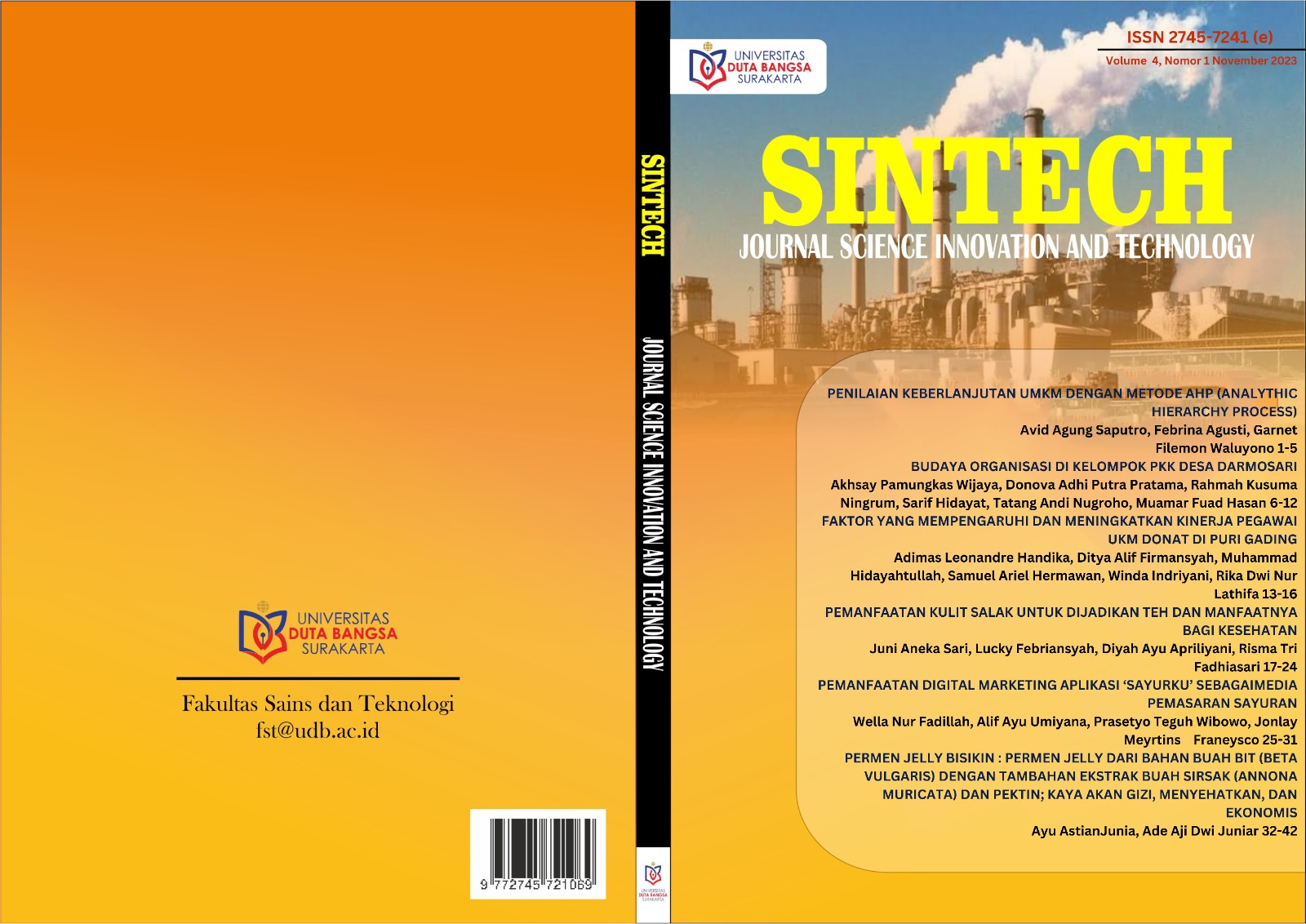Penilaian Keberlanjutan Umkm Dengan Metode AHP (Analythic Hierarchy Process)
Penilaian Keberlanjutan Umkm Dengan Metode AHP (Analythic Hierarchy Process)
DOI:
https://doi.org/10.47701/sintech.v4i1.3747Keywords:
Analytic Hierarchy Process, SustainabilityAbstract
Micro, Small and Medium Enterprises (MSMEs) are an essential pillar in the growth of the Indonesian economy, because they are part of the business units that can develop and be stable in the national economy. Sustainability is a concept applied in companies so that a company can achieve sustainability in its business for the long term. There are three aspects of sustainability, namely economic, environmental and social. These three aspects are fundamental things that must be achieved by companies, including SMEs, in order to achieve sustainability targets. As is the case with Pak Didik's tofu-making UMKM in Cerbonan, Karanganyar. The obstacle faced by MSMEs is experiencing a decrease in buyers or a lack of buyers. The Analytic Hierarchy Process (AHP) method is a decision support method by breaking down complex problems into a hierarchy. With hierarchy, complex problems can be broken down into several groups to make them more structured and systematic. Based on the results of the discussion, the conclusion in this research is that the priority order for market position and competitiveness criteria is the 1st priority with a weight value of 0.90 or 90%, next system optimization is the 2nd priority with a weight value of 0.57 or 57%. , then social responsibility becomes the 3rd priority with a weight value of 0.50 or 50%.
References
Abdiputra, 2019 Strategi Pengembangan Usaha Bidang Bakery. Prosiding SemNas. Vol.1. TI.131-TI.136. Diakseshttps://e- journal.umaha.ac.id/index.php/teknik/article/download/688/55
Cahyono & Kunhadi, 2020 Strategi Pengembangan UKM Gethuk Pisang Guna Melestarikan Makanan Tradisional. Jurnal Media Teknik dan Sistem Industri. Vol. 4 (no. 1) (2020) hal. 10-17. (https://jurnal.unsur.ac.id/, diakses 17 Juli 2023).
Delmayuni et al., 2017 tudi, P., Manajemen, I., & Pascasarjana, S. (2017). Strategi Peningkatan Daya Saing Umkm Pangan Di Palembang Strategies to Increase the Competitiveness of Food’s Small Medium Enterprises (SMEs) in Palembang. Buletin Ilmiah Litbang Perdagangan, 11(1), 97–122.
Putranto et al., 2019 Penetapan Pembatasan Sosial Berskala Besar (PSBB) Di DKI Jakarta Dalam Rangka Percepatan Penanganan Corona Virus Disease 2019 (COVID-19)
Pratiwi 2014 Analsisi SWOT Pada UMKM Keripik Tempe Amel Malang Dalam Rangka Meningkatkan Daya Saing Perusahaan.â€, Jurnal Administrasi Bisnis (JAB), vol. 43 No.1 Februari.
Rahmanto et al., 2018 Peran Komunitas Dalam Meningkatkan Kinerja Ukm (Ditinjau Dari Faktor Internal) Jurnal Riset Manajemen dan Bisnis (JRMB) Fakultas Ekonomi UNIAT Vol.3, No.1 Februari 2018: 1 – 10
Sarfiah et al., 2019 UMKM SEBAGAI PILAR MEMBANGUN EKONOMI BANGSAâ€. Jurnal REP (Riset Ekonomi Pembangunan), 4 (2).
Ubaidillah 2022, Pelanggan Gojek Sebanyak 50% Naik GoRide SebagaiTransportasi Publik. https://inet.detik.com/cyberlife/d-5120764/50-pelanggan-gojek-naik-goride-untuk-jangkautransportasi-publik
Winarti et al., 2019 Analisis Faktor-Faktor Yang Mempengaruhi Daya Saing Usaha Mikro Kecil Dan Menengah (UMKM) Di Perkampungan Industri Kecil (PIK) Pulogadung Jakarta Timur. Lentera Bisnis, 8(2), 38–48








